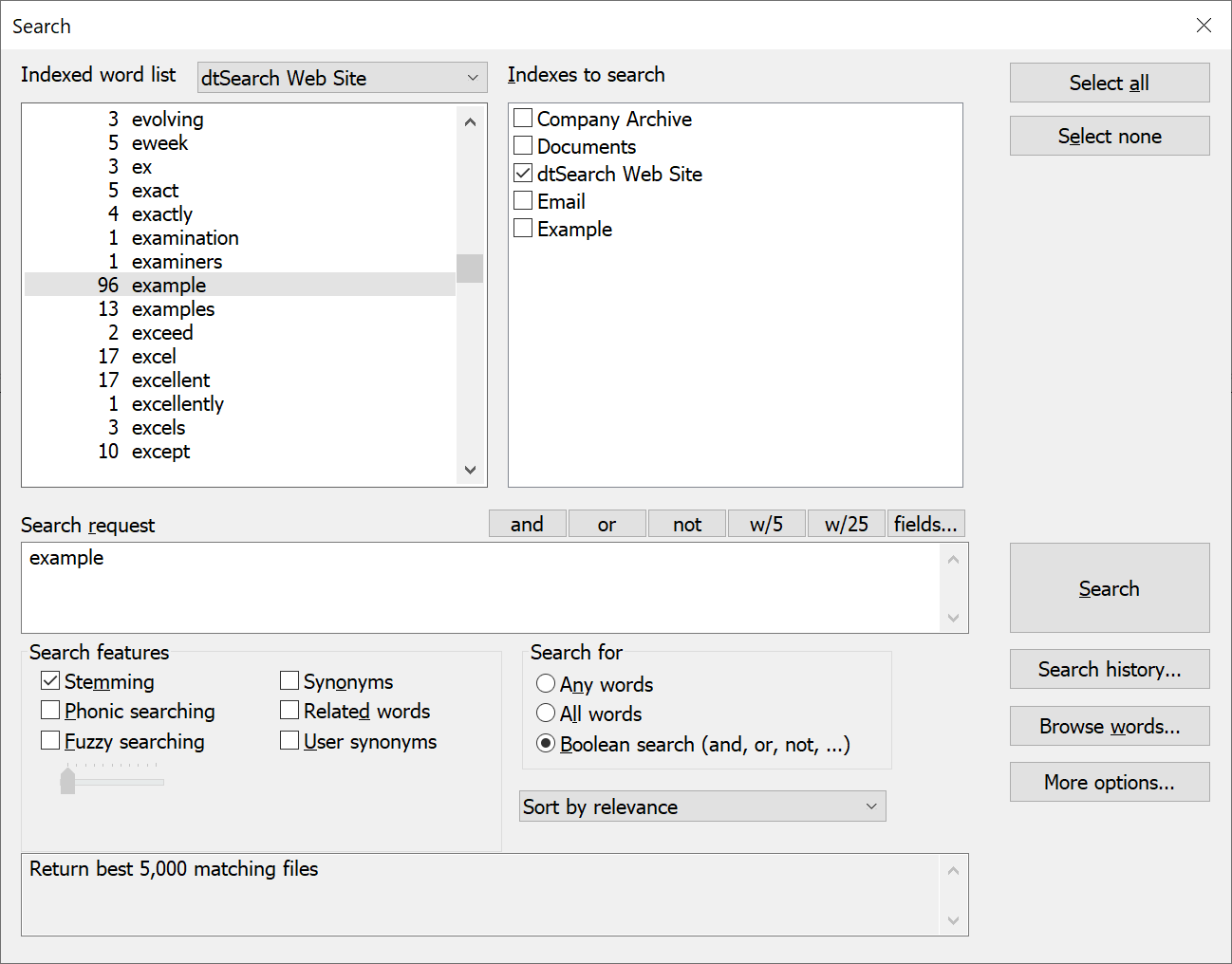Search Dialog Box

First, tell dtSearch where you want to search
1. Under Indexes to search, click on the name of each index you want to search.
2. To search without an index, click the More Options tab. Under Unindexed search options, select whether you want to combine the unindexed search with an index search. Click the Add Folder... button to select the folders to search.
3. To limit your search by filename, date, or size, click the More Options button and then enter the criteria for your search. More Options also provides a way to limit the number of files retrieved to the most relevant.
Next, tell dtSearch what you want to find
1. Select one of the three search types:
A boolean search request consists of a group of words, phrases or macros linked by search connectors such as AND and OR to precisely indicate the relationship between them.
An "any words" search request consists of an unstructured natural language or "plain English" query. In an "any words" search request, words such as AND and OR are disregarded. Use quotation marks to indicate a phrase, + (plus) to indicate a word that must be present, and - (minus) to indicate a word that must not be present.
An "all words"search is like an "any words" search except that all of the words in the search request must be present for a document to be retrieved.
2. Enter a search request in the space provided.
3. Select the search features to use in your search.
Stemming searches other grammatical forms of the words in your search request. For example, with stemming enabled a search for apply would also find applies. Click the drop-down list of languages to select a stemming language other than English.
Phonic searching finds words that sound similar to words in your request, like Smith and Smythe.
Fuzzy searching sifts through scanning and typographical errors.
Synonym searching tells dtSearch to use a thesaurus to find synonyms of words in your search request. dtSearch provides three ways to perform synonym searching:
Check Synonyms to find synonyms using the WordNet concept network included with dtSearch.
Check Related words to find related words from the WordNet concept network.
Check User synonyms to find synonyms that you have defined in your own thesaurus.
4. Click Search to start the search.
Sorting Options
Sort by relevance
By default, dtSearch sorts retrieved documents by their relevance to your search request. Weighting of retrieved documents takes into account: the number of documents each word in your search request appears in (the more documents a word appears in, the less useful it is in distinguishing relevant from irrelevant documents); the number of times each word in the request appears in the documents; and the density of hits in each document.
Sort by date
Select date sorting to get the most recent documents that match your search request, rather than the most relevant.
Sort by hits
Sorting by hits uses a simple count of the number of hits in each document (with no automatic term weighting) to rank retrieved files.
After the search is over, you can re-sort the results by clicking the column headers in the search results list.
Search Tools
Word List
At the top of the search dialog box is a scrolling list of the words in the index you have selected. Next to each word is a number, which is the number of times the word occurs in the index. As you type in a search request, the list will scroll to the word you are typing. If you have selected more than one index to be searched, you can pick the index listed in the word list from the drop-down list on top of the word list.
Fields
Click the fields... button to see a list of the searchable fields in the selected indexes.
Browse words
Click the Browse Words... button to see how dtSearch will search for words using fuzzy searching, phonic searching, stemming, or synonym expansion.
Thesaurus
Click the Thesaurus... button to browse the thesaurus.
Search history
Click the Search History button to see a list of your most recent search requests.
Searching within a previous search
After a search, click Search > Search within these results to do another search of just the documents retrieved in your previous search. You can also use Search within these results to search within the results of a search that you open from Search History.